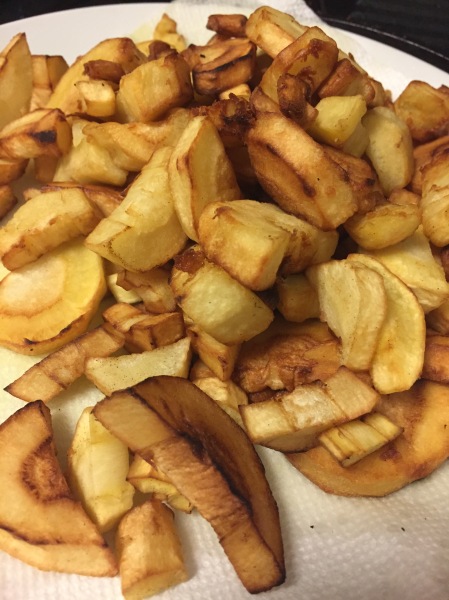“Then there is the carrot. ‘This vegetable,’ says Diphilus, ‘Is harsh, but tolerably nutritious, and moderately good for the stomach; but it passes quickly through the bowels and causes flatulence. It is indigestible, diuretic, and not without some influence in prompting men to amatory feelings, on which account it is called a love-philtre by some people.” ~ Athenaeus, Deipnosophistae [The Philosophers’ Dinner-party], 2nd century CE

The Ancient Romans didn’t eat fries in cones of wax paper, but they should have.
We hold these truths to be self-evident: carrots are orange, parsnips are white. But it wasn’t always that way.
From a botanical standpoint, the two plants are different enough to keep them out of the same genus (they belong to Pastinaca and Daucus, respectively). Most modern people simply use color to tell them apart. But ancient people tended not to differentiate between these two tapered, edible roots, in spite of the fact that parsnips seem to have been first cultivated in northern Europe and carrots in Persia. In Old English, for example, both were called by the same name, moru. The Romans had two different words but used them interchangeably, just as the roots were used interchangeably in their cuisine. Apicius, the compendium of all things Roman and culinary, offers recipes for carotae seu pastinacae, carrots or parsnips. The ancient confusion hints at the carrot’s biggest secret: it wasn’t always orange.
Farmers selectively breed their crops, encouraging desirable traits like size, productivity, and sweetness to create new cultivars and strains. Our modern food plants have been genetically manipulated for so long by human beings that they look extremely different from their ancient ancestors (who says GMOs are a recent phenomenon?) Ancient fruits and vegetables had more of the “bad” qualities that have been bred out in the centuries since: you can bet that the Romans never heard of a seedless grape. Color is a trait that can be selected for just like any other, and Roman carrots, in addition to being smaller and less sweet than our modern ones, only came in purple or a very parsnip-like white. So where did orange carrots, rich in the same beta-carotene that gives everything from pumpkins to flamingos their color, come from?
Scientists believe that a genetic mutation in the purple carrot resulted in the first yellow carrots around the 11th century, which was then selectively bred to create our modern orange. A popular legend asserts that orange carrots were developed in the 17th-century Netherlands as a tribute to the Dutch royal family, the House of Orange-Nassau. The Orange in that family’s name refers to the French principality of Orange, a transformation of the Latin place-name Aurasio that came to be associated with both the color and the fruit. But should we believe the carrot-as-political-tribute story? Maybe. It’s true that the Netherlands was known for its carrot production in the 17th century. It’s also true that a century later, “carrots sold with their roots too conspicuously showing were deemed provocative” by the Dutch Patriot party who forced out the House of Orange. But whether the orange carrot was actually developed in tribute to the House of Orange is unknown, though it’s the kind of unqualified claim that frequently gets presented as fact in places like tourist guides and bar trivia.
All this means that when reconstructing a Roman recipe in your modern kitchen, orange carrots are to be avoided at all costs, but parsnips or carrots in other colors will do just fine. The Roman love for both vegetables is well-documented. In the first century BCE, they were demanded as tribute from the tribes of Germany by the Emperor Tiberius; two hundred years later, the Roman-Greek writer Athenaeus records their health benefits in the text quoted above, including the ability to rouse sexual desire in men.* Any aphrodisiac qualities attributed to carrots and parsnips by the Romans are likely due to their phallic shape. In ancient medicine, this was the plant’s “signature”, the physical resemblance between a plant and the part of the human body it could cure or affect. This belief continued well into the Medieval period, when for example walnuts were believed to be good for brain health because a walnut looks like a tiny, wrinkled brain.
In this simple and delicious recipe from the Roman cookbook Apicius, the roots are fried in olive oil and dressed with a pungent savory/salty sauce called oenogarum, a reduction of red wine, fish sauce (garum) and pepper. We might consider this recipe an antecedent of French fries with ketchup. The parallel is a surprisingly close one; the South American potato would eventually dethrone the parsnip as the favorite starchy vegetable in Europe, while ketchup arose from the same origins as Roman garum.
INGREDIENTS
- 3 large parsnips or (non-orange) carrots
- Enough olive oil to fill a pot about two inches deep
- 2 cups red wine
- 1/3 of a cup fish sauce
- 2 teaspoons ground black or long pepper
- 1 tablespoon of cornstarch
Wash and peel the parsnips and cut them into small pieces. I did half-circle wedges, but you could also try a traditional French fry shape. Dry the parsnip pieces thoroughly with a paper towel.

This is what happens when you put moist, fresh vegetables into hot olive oil. Be careful!
Fill a pot with olive oil up to around two inches and raise the heat to medium-high. After a few minutes, drop a small piece of parsnip in to test if the oil is hot enough to fry. When the oil is ready, fry the parsnips a few pieces at a time (they are moist and will produce a lot of bubbles). Move the parsnips around with a wooden spoon or other tool to prevent them sticking.
When the parsnips are golden brown on the outside, remove from the oil and drain on a plate lined with paper towels.
Next, make the oenogarum. Bring the red wine to a low boil in a saucepan. When it has reduced by about one-third, add the fish sauce and pepper. Mix the cornstarch and about half a cup of water into a slurry in a separate bowl, Slowly add this to the wine while stirring with a spoon to prevent clumping. Reduce the mixture another third. The end result should have the consistency of barbecue sauce, thicker than water but liquid enough to pour.
Serve as you would French fries and ketchup, with the wine-sauce drizzled on top of the parsnips or on the side for dipping.

These pastinacae are ready to prompt men to amatory feelings.
VERDICT
I feel like with every ancient recipe I make, I claim that it’s the best one ever. I’d better start on that rose-and-lamb-brain patina, or the dish invented by Emperor Vitellius that contained fish semen. This one really is good though! The parsnips are soft on the inside and crunchy outside, and the oenogarum has a powerful blend of flavors that provide the salt and other seasoning. I wouldn’t want to eat the oenogarum on its own, but it’s perfect when balanced against the bland starchiness of the parsnips. This is one of the first Roman recipes I could genuinely imagine someone ordering from a modern restaurant (or a food truck, for that matter, which inspired the photo above). X out of X.
I had no idea that carrots inspired such strong opinions! This post is brilliant.
Do you make your own garum or will a Thai fish sauce do?
LikeLike
Haven’t made my own garum, although it’s on my list of recipes to attempt! I do use store-bought Asian fish sauce for Roman recipes; although it was developed independently, it’s basically the same thing.
LikeLike
Good to know if I ever get up the gumption to start making Roman recipes! 🙂
LikeLike
Pingback: Holidays: Yo, Saturnalia! (Roman, unknown – 5th century CE) | Pass The Flamingo: Ancient Food History and Recipes